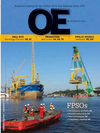
Page 72: of Offshore Engineer Magazine (Sep/Oct 2014)
Read this page in Pdf, Flash or Html5 edition of Sep/Oct 2014 Offshore Engineer Magazine
Subsea
Sensing systems
Optical and even quantum sensing is being assessed to help monitor the subsea oil? elds of the future as part of remote sensor networks. reports on work in
Elaine Maslin the ? eld by the University of Aberdeen.
Subsea monitoring using radio he amount and complexity of early leak detection, with automated frequency. Image from WFS. subsea production equipment is leak warnings, as well as hydrocarbon
T growing. In 2013, about 20% of ? ow monitoring and pipeline integrity
UK offshore production, or 280,000boe/d monitoring. “Environmental leakage, presence of hydrocarbons.” was from subsea developments, a ? gure without having to introduce tracers into Options using optics were researched by set to rise to about 400,000boe/d by 2016. the ? ow, is going to be one of the biggest Johannes Kiefer, an honorary professor
Subsea separation is growing in use and areas,” Neilson says. “The other holy grail and former senior lecturer at University subsea gas compression is nearing its ? rst is pipeline inspection,” Neilson adds. “If of Aberdeen’s School of Engineering. commercial use. you could ? y an AUV along the length of They include infrared and near-infrared
As these developments come online, the pipe to detect wall thickness, corro- spectroscopy, Raman and ? uorescence in ever deeper, or harsher waters, where sion pitting, hydrate formation or waxing, spectroscopy, and UV/LED absorption local, manned structures may not be instead of putting a pipeline inspection and ? uorescence (see panel).
possible, or are too costly, the need for gauge through the pipeline, with the • Infrared (IR) spectroscopy - an absorp- remote monitoring, especially leak detec- potential to have it jam and interrupt pro- tion technique using molecule speci? c tion, is also increasing. duction, which would be ideal.” absorption in the mid-infrared spectrum,
While operators and contractors work The S3C program assessed various where the vibrational frequencies of mol- out how to make variable speed drives sensor types, including spectroscopy, for ecules can interact with radiation, e.g. work in 3000m water depth, others leak detection, and has developed a new each hydrocarbon species exhibits a ? n- have been focusing on future monitor- technique, quantum sensing, for pipe- gerprint IR spectrum, so the IR spectrum ing systems, including the University of line inspection. It also looked at what is of a mixture can be used to quantitatively
Aberdeen. needed to support subsea sensor net- analyze the chemical composition.
The university is researching the dif- works, such as wireless sensor and com-
Moreover, IR spectroscopy is sensitive to ferent types of sensor systems required munication networks and subsea power. the chemical environment of a species, for remote subsea developments, under allowing the investigation of e

 71
71

 73
73